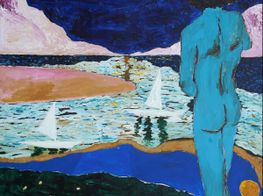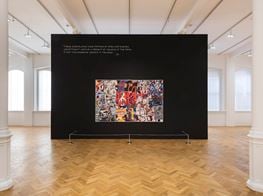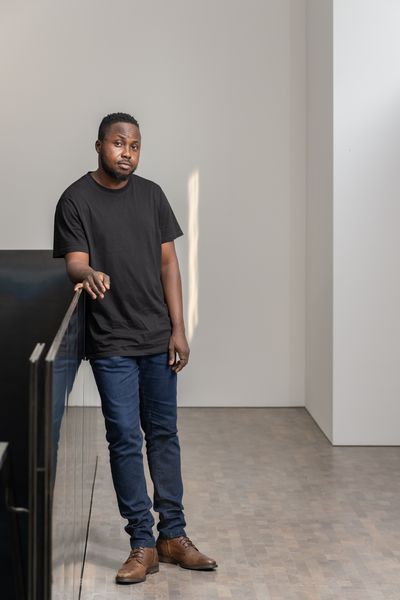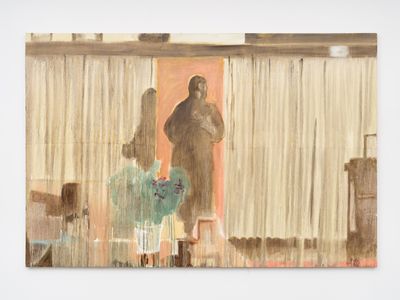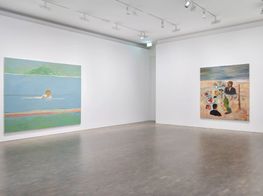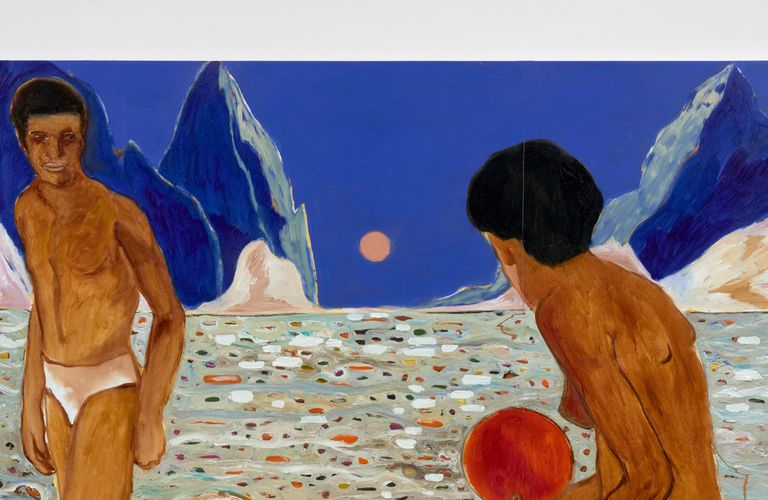
Gideon Appah Captures Sensations
of Ghana in Pace Debut
In the last five years, Ghana has become a hotbed for some of the most sought-after artists of our generation.
Accra-born Gideon Appah is at the centre of this artistic cohort, with the famed Amoako Boafo, Otis Kwame Kye Quaicoe, and Kwesi Botchway among its ranks.
Receiving his BFA from Kwame Nkrumah University of Science and Technology in Kumasi, Ghana, in 2012, the young artist has gone on to impress both at home and abroad with his surrealist charm.
Six months after announcing his representation, Pace Gallery hosts Appah's first solo U.K. exhibition, How to Say Sorry in a Thousand Lights (15 March–15 April 2023), which takes over their Hanover Square gallery in London.
Ahead of the opening, Appah sits down with Ocula Advisor Rory Mitchell to speak about his day-to-day in the studio, Ghanaian films that inspire his practice, and reveals future projects.
Can you tell me about your studio in Accra? Is there a large community of artists nearby?
Many artist communities and residencies, such as the Noldor Artist Residency, are near or in the city centre, but I choose to work in a beautiful landscape close to the sea.
My studio is light and peaceful and gives me a sense of space. Being larger than my last, it allows me to create works on a more ambitious scale. I also enjoy the quiet as it gives me time to meditate. This is all part of the painting process—having time for yourself, and knowing what works best for you. I normally work at night for peace and quiet.
What's your typical routine in the studio?
Part of the process of working at night is that we also sleep. I will often get to the studio at 6 pm and start to put things together—sketching and developing the works. My team and I then have dinner before setting to work again.
As I normally handle four brushes at once, I don't want to be picking up paints. So I often assign different colours to each assistant. They will help with topping up my palette, cleaning brushes, and help me as I work around the canvas.
The colouration and composition of The Acrobat (2023) remind me of this amazing Noah Davis painting, 40 Acres and a Unicorn (2007), which depicts a male figure on a horse.
Was this an inspiration for the work?
I'm familiar with Noah Davis. However, this particular work speaks to my love of horses and the skill of an acrobat working with a horse. They're both imagined, painted in white on a stark black background as if there's a spotlight shining down on the two performers.
Over the years, I've painted many horses and men, but I treated this one differently. It was also the first time I painted an acrobat. I wanted to capture a figure balancing with arms stretched on the back of a horse.
For Seated Man (2021–2022) and The Sensitivity of Everyday Things (2021–2023), the inspiration comes from a desire to show a range of non-representational still lifes, figures, and landscapes on one canvas. The landscapes are flat, the figures nondescript, and the range of colour—purples, greys, and yellows—in muted tones create a hazy, dream-like light.
Blue appears to be the dominant colour throughout the show, yet your figures seem to be outlined by a yellow glow. Could you speak about your process?
I prefer blue to many colours. In fact, many of the works in the show are painted in light ultramarine.
I usually mix different shades into the blue to achieve depth. While the skies are lighter in shade, the darker blues of the waters pull you in, and for me, inspire the contemplation and meditative state I feel when I am painting.
Maybe I'll fall in love with another colour later, but for now, I'm loving what it's giving me. The yellow you see is the yellow acrylic I use to draw the figure's outline. I'll then often add two or three shades onto the figure to prime the canvas before I paint.
Every painting in the show is a mix of oil and acrylic paint. I only started using oil paint in 2020. A friend sent me a small box of Williamsburg oils. First, I thought, 'How can I paint in oils?'. But I gave it a try, and it's come to stay.
Acrylics—especially, thick acrylics—are great for texture. But oils give me fluidity. They give me that freedom and movement.
And your figures? What's the story behind them?
I often reference Ghanaian newspapers—Daily Graphic, The Mirror, Ghanaian Times—dating back to the 1960s and 70s. A friend introduced me to an old man who used to sell newspapers and had boxes of them from back in the day.
He wanted to keep them to give to his grandchildren, but gave me a box. In the entertainment column, I came across adverts for 1970s, 80s, 90s Ghanaian films featuring silhouettes of suited men smoking cigarettes and images of erotic dancers. Their hair—permed like rock-day dancers—takes you back. It's old school.
Cloud Men (2021–2022) is a mix of these clippings. Each figure is cut from a different clipping and era, expressed in a range of outfits. I like the idea of bringing these men from different times and walks of life together. While at first glance, the scene appears timeless, the longer you look, the more apparent these subtle nuances become.
The landscapes, culture, and social fabric of Ghana have played a steadfast role in your practice. How does your hometown of Accra feature in this Pace Gallery show?
Scenes from Ghanaian films like The Boy Kumasenu (1952), Mr. Mensah Builds a House (1956), Kukurantumi – Road to Accra (1983), and Shoe Shine Boy (1992) have worked their way into a number of artworks in this exhibition.
The Contemplation (2023) was inspired by Shoe Shine Boy, a classic Ghanaian film. There is one scene I love: a boy is pictured standing in the hallway, waiting for his father to come home. The sepia tones of The Contemplation are a response to the film's muted colour.
Any upcoming projects?
I am part of a group show at the Newport Art Museum in Rhode Island in July 2023. —[O]
Main image: Gideon Appah, Red Sun (2022) (detail). Oil and acrylic on canvas. 179.7 x 200 x 3.8 cm. © Gideon Appah. Photo: Robert Glowacki.

